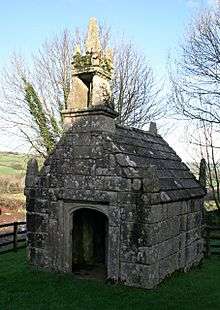Dupath Well
Coordinates: 50°29′56″N 4°17′17″W / 50.499°N 4.288°W

Dupath Well (Cornish: Fenton Hynsladron[1] Eng: 'Robber's Path') is a holy well house and chapel dedicated to St. Ethelred, constructed over a spring. It is a Grade I listed building, having been added to the register on 21 July 1951.[2]
The structure
Dupath Well is a nearly intact well-house, constructed of local granite, built over a spring. Built of Cornish granite ashlar, it has a steeply pitched corbelled roof, built from courses of granite slabs that run the length of the building. There are badly weathered pinnacles at each corner and a small bell turret with a highly elaborate canopy, possibly a later addition,[3]over the entrance. Next to the well house is a medieval, circular trough that collects the spring water.[4]
History
The small chapel-like building was probably built in about 1510 by the Augustinian canons of the nearby priory of St Germans, to whom the site belonged. The architecture of the well-house is typical of the late 15th and early 16th centuries in a notably 'Celtic' style bearing comparison with similar well houses and ancient chapels in Brittany and Ireland, albeit in a late medieval elaborated form.[4]
At one time the spring at Dupath was believed to cure whooping cough, and it has been suggested that, in addition to its role in healing the sick, the spring may have been used on occasion for baptisms. One grim tale associated with Dupath recounts that two Saxons – Colan (Cornish for heart or courage) and Gottlieb – fought a duel there for a lady’s hand. But the maiden went unmarried: Colan was killed outright and Gottlieb fatally wounded, though some versions say he died later of ‘impatience’.[5]
Dupath Well is located at grid reference SX 374 693, just outside the town of Callington in east Cornwall, United Kingdom. It is under the guardianship of Historic England, and managed by the Cornwall Heritage Trust.[6]
References
- ↑ "Place names in the SWF". MAGA. Retrieved 13 August 2016.
- ↑ "Dupath Well, Callington". British Listed Buildings. Retrieved 13 August 2016.
- ↑ Historic England. "Dupath Well (Grade I) (1140066)". National Heritage List for England. Retrieved 1 October 2015.
- 1 2 "Dupath Well". Pastscape. Historic England. Retrieved 1 October 2015.
- ↑ Meyrick, J A 1982. 'Pilgrim's Guide to the Holy Wells of Cornwall', Falmouth: Falmouth Printing Co
- ↑ "Dupath Well". English Heritage. Retrieved 13 August 2016.
External links
| Wikimedia Commons has media related to Dupath Well. |